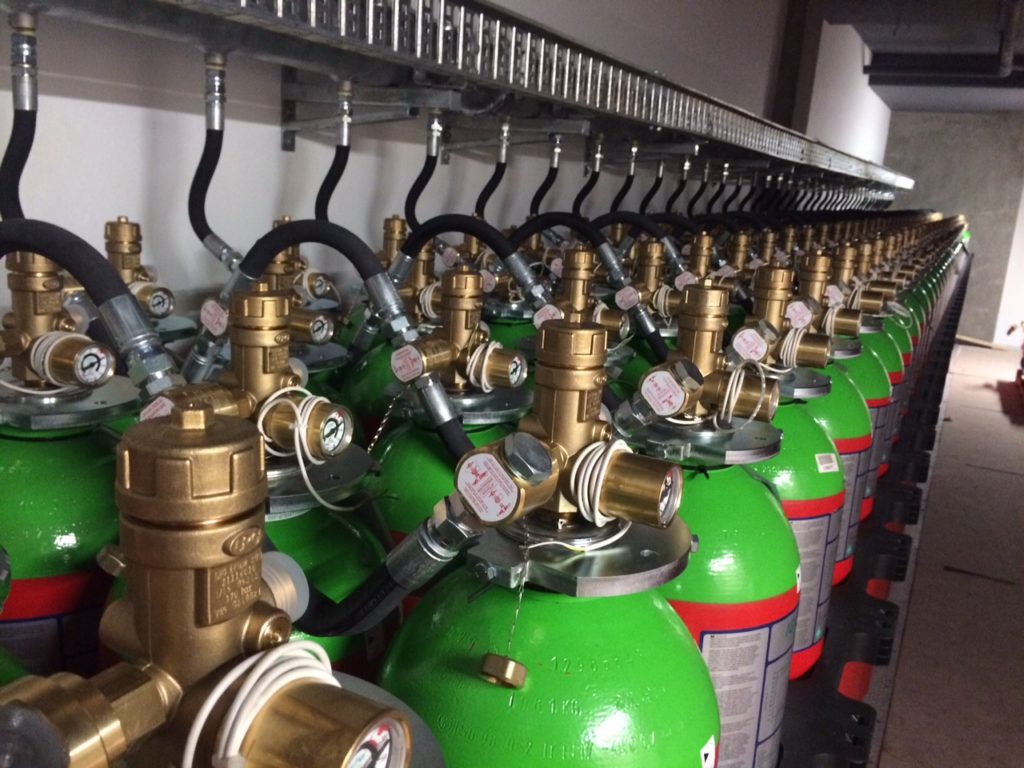How to Safely Handle Industrial Gas Cylinders
Compressed gases in cylinders are dangerous goods and should only be handled by employees and contractors trained in correct handling techniques. This blog looks at Industrial Gas Cylinders; how they are used in the workplace is a risk to health and safety, and the proper way to handle them.
Industrial Gas Cylinders in the Workplace
Compressed Industrial Gas Cylinders are used in homes and workplaces all over the world, and it can be said that the unique chemical properties of gases and other hazardous chemicals make our comfortable 21st century life possible.
Industrial applications of compressed gases include:
- Fuel gases such as LPG electric forklifts in warehouses, gas heaters in restaurants and welding torches in workshops;
- Poisonous gases like chlorine purify water treatment plants and swimming pools
- Pure oxygen gas is used for yeast activation and preservation in wineries, industrial welding and medical treatments
- Corrosive gases such as ammonia are used for cooling cold storage plants and for the manufacture of plastics.
- Industrial gases such as helium, hydrogen, argon and nitrogen are used to maintain laboratory equipment
- Oxidized gases such as nitrogen dioxide are used to bleach flour and are also a component in rocket fuel
- Reactive gases such as acetylene are used for welding and industrial cutting.
Note: Compressed gas bottles are never really empty. Even if the gauge reads 0, the residual gas will always remain in the cylinder. Always treat the empty cylinder as the full cylinder with the same caution.
Handling Risks and Hazards
Pressurized gases must be handled correctly. The Industrial Gas Cylinders itself is heavy and of odd shape, so handlers are prone to hand injuries like sprains, strains, falls, bruises, or broken bones.
If the gases are released by mistake, at the same time, the wrong cylinders are dropped, affecting or affecting them. If gases leak from the damaged cylinder, the following catastrophic hazards are most likely:
- The fire
- Explosion
- Chemical burns
- Burns cold
- Hazardous exposure to toxic and corrosive gases
- Effect from cylinder in ‘torpedo-like’ motion
- Asphyxia from oxygen displacement
Safely Handle Industrial Gas Cylinders
1. Mechanical Lifting
Devices Are Used When Transporting Gas Cylinders
A worker suffered multiple fractures and was hospitalized after a cylinder, after which he went ahead and crushed his leg. This accident could have been prevented if the worker had used a forklift to move the Industrial Gas Cylinders. The standard requires that cylinders be lifted and moved only with mechanical lifting equipment (like a forklift), and care must always be taken to ensure that cylinder valves are always protected from damage. Cylinders should never be dropped or rolled on the side of trucks.
2. Cylinder Valves
Are Protected At All Times
An employee was on the ladder while soldering the pipe. He placed the torch cylinder on a wooden beam between the welds, which later fell to the ground. The neck of the cylinder was open and the cylinder engulfed in flames caused the labourer to burn 3 degrees and tried to jump from the ladder. The standard requisite a purpose-built gas bottle trolley or cage that has individual restraint and protects the valve and regulator from damage.
3. Cylinders Are
Securely Restricted
An employee who checked the cylinder for leaks died due to the rapid spread of gas, as well as a loose cylinder running in the air. This workplace accident is a sad example of why the standard requires that Industrial Gas Cylinders should be kept upright and safely handled at all times.
4. Appropriate PPE Is
Provided For Employees
The use of substandard PPE causes injuries and accidents - like an employee who burned his hands 2 degrees while wearing only cotton when changing LPG cylinders. Always consult the Safety Data Sheet (SDS) for each of the gases handled and stored at your workplace and ensure that PPE is well maintained and easy to find.
5. Employees Are
Clearly Instructed and Adequately Trained
Two workers were killed and another was seriously injured while moving LPG cylinders down the stairs. A worker dropped a cylinder that affected another worker and then exploded.
It is essential that employees understand the chemical properties of the gases that they use and handle, as well as the hazards associated with cylinders. They should be given clear and specific manual handling procedures as well as ongoing re-training.
Other Cylinders Handle Best Practices
- Transport cylinder with valve closed and cap in place
- Never use the cylinder cap or valve to lift or move the cylinder
- Do not accept High Pressure Gas Cylinders that have no label or identification, and never rely on color alone to identify the gas inside the cylinder
- Visually inspect the cylinder and do not accept anything damaged, discolored or appearing during the test date
- Do not try to catch the falling cylinder, be clear
- Industrial Gas Cylinders are regularly tested and saved by qualified technicians
- Never pull or drive cylinders even for short distances
- Do not interfere or remove cylinder labels, markings or paintwork



Thank you so much for sharing about Industrial gas supplier
ReplyDeleteThat's great news dear author thanks for sharing with us. Industrial Gas Manufacturers
ReplyDeleteI have been searching for such an informative publication in Industrial Gases Supplier many ways, and it seems that my search here has just ended. Good job. Continue publishing.
ReplyDelete